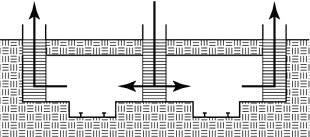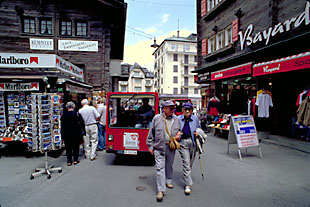 Sample ChapterThis sample chapter gives an indication of the layoutof the book, but such subtlties as baseline alignment are impossible in HTML. In addition, the illustrations are necessarily of far lower quality than they will reproduce in the finished book. The text has also undergone some revision since this page was created in mid-1999.
A browser window of at least 1024 x 768
|
PASSENGER TRANSPORT |
|
| Downtown intercity rail station, 4-track metro lines, and metro-freight routes. [The moiree pattern does not appear in the finished drawing.] |
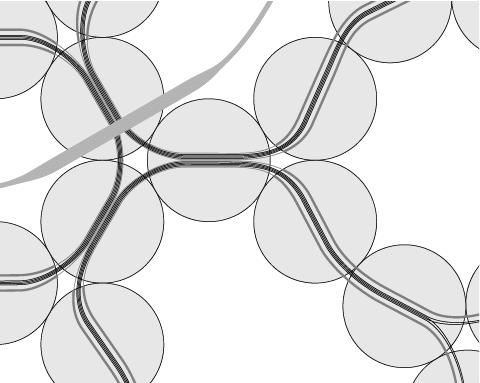
|
| Opposite: [not shown in Web version] Profiles of the passenger and freight metro systems. The upper profile shows the layout of the passenger and metro-freight systems in the three downtown districts (where the lines are brought adjacent to each other for transfers). The middle profile shows the four-track metro and doubled metro-freight system in the 12 inner districts. The bottom profile shows the two-track metro and sinlge metro-freight line in the 66 outer districts. | Superlative passenger transport is the only foundation upon which a carfree city can be built. Fortunately, existing rail technology easily fulfills the need, and we even have the luxury of a choice between two excellent systems: a heavy-rail underground system (metro) or a surface Light Rail Vehicle system (tram). Another possibility is an improved bus system, as is used in Curitiba. A long-term possibility is Personal Rapid Transit, which is not yet fully developed and ready for installation as a high-capacity urban transport system. This chapter describes in detail the passenger transport system for a carfree city; freight delivery is taken up in the next chapter. |
| While the reference design for carfree cities might have been predicated entirely on bicycle transport, I have, in fact, assumed that public transport will provide all movement between districts. I have made this assumption because only a few cities enjoy sufficiently mild weather to permit year-round bicycling except by dedicated enthusiasts. In most climates, the transport system must be capable of meeting all transport needs during weather extremes. During fair weather, bicycling reduces the load on the transport system, is pleasant and healthy, and often provides the fastest door-to-door transport. For this reason, the needs of bicyclists remain a high design priority, notwithstanding the capability of the transit system to provide all passenger transport. | |
| Journeys fall into three categories: within the district, between districts, and between the city and outlying areas. We will consider each of these in turn. | |
Transport Within the District |
|
| Most transport within the district will be on foot. No two doorsteps in a district would lie more than 10 minutes' walk apart. However, walking will not meet all passenger transport needs within the district. For the longer distances, many people will prefer to bike. For the very young, the very old, and those with disabilities, an alternative way to get around will be needed. Various simple, inexpensive, non-intrusive vehicles can meet these needs: | |
|
|
| The most difficult issue affecting transport within the district is the matter of right-of-way. While individual cities will make decisions based on local needs, the following general principles help assure safe, pleasant streets. | |
Pedestrians Own the Street |
|
|
Routine use of police squad cars is probably unnecessary–experience with police patrols mounted on bicycles has been good, and provisions for battery-boost during emergencies already exist. |
One fundamental principle must be maintained: pedestrians take precedence over all other street users, no matter how inconvenient that may be for wheeled traffic. The only exceptions are emergency vehicles, of which there should be very few. All other street users must stay out of the way of pedestrians, including bicyclists, delivery vehicles, and carts. Because vehicle speeds will be very low, any conflicts between street users should be resolved without bodily injury, even if some harsh words are exchanged. The narrow streets will be adequate to the demands imposed upon them, possibly excepting the narrowest streets, where bicyclists may be expected to dismount and walk for safety reasons. Bicyclists may also be expected to ride at slow speeds on most streets, out of consideration for other street users. Only emergency vehicles should ever travel faster than a reasonably fit runner can sprint. |
| We come now to a delicate issue: many of the problems with cars also apply to bicycles, albeit to a far lesser degree. One of the reasons that Venice is so relaxing is the complete absence of street traffic moving faster than a pedestrian. Only under these circumstances can people on foot truly let down their guard. Bicycles have the following problems in common with cars: | |
|
|
| In particular, bicycle parking near a metro or tram stop could become a problem. It may be easiest simply to discourage people from riding their bikes to the stop; otherwise, thousands of bicycle parking spaces may be required at each stop. | |
| Bicyclists in Amsterdam now routinely ride on the sidewalks and expect pedestrians to stay out of their way. The reason is simple, of course: too many cars in the street. The change, however, removes the last bastion of safe walking. Downtown Amsterdam doesn’t have enough space to solve this problem except, of course, by removing the cars. | A few bicyclists adopt a holier-than-thou attitude that arises from their belief that they alone are not burdening the environment by their choice of transport. In a city without cars or trucks, this attitude should disappear by itself, and bicyclists should help to keep the streets safe for everyone, but some degree of police enforcement probably will be needed. |
Bicyclists Own the Boulevard |
|
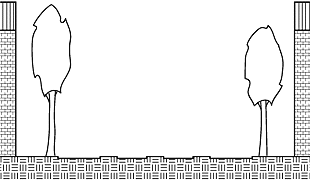 Boulevard cross-section and plan (metro) |
There is one place where bicyclists can ride fast: the central boulevard is their kingdom. Speeds here would be unrestricted, and bike lanes would be wide enough to provide sufficient capacity for the anticipated traffic. This may vary from city to city, depending on culture, weather, and topography, so the width of the boulevard bike lanes will be adjusted to suit local conditions. Five meters in each direction is probably adequate in most cases and is the standard assumed in the reference design. In order to provide safe crossings of the boulevard, traffic signals may be necessary at some or all intersections. Opposing traffic will be separated by a median, making it possible to time the lights separately for each direction, so fast-moving bicyclists will rarely have to stop. Bicyclists who fall behind the signal phase will encounter some red lights, but the duration of the red cycle need only be long enough to permit waiting pedestrians to cross the bike lane. |
Requirements for Inter-District Transport |
|||||||||||||||||||||||||||||||||||||||||||||||||||||||||||||||||||||||||||||||||||||||||||||||||||||||||||||||
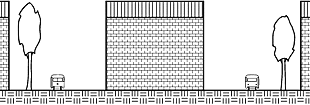 Boulevard cross-section (trams) The importance of getting the topology right was brought home to me when I lived in Quincy and commuted to East Boston (Massachusettes). I had to take an intermediate metro because the line from Quincy did not connect directly with the line to East Boston, even though they came within a few hundred meters of each other. This fault cost me 15 minutes a day.
|
The need for passenger transport between districts imposes a variety of requirements on the design of a carfree city. I have assumed that the system must be capable of transporting one-third of the city's residents towards downtown during the morning peak hour. This might be a somewhat low estimate but for the fact that many schools and workplaces will be situated within the same district as the student's or employee's residence; these people will not require inter-district transport at rush-hour. In addition, there will be a substantial number of "reverse commuters," those whose commute does not take them in the direction of downtown. Detailed computer simulation of travel patterns will be necessary to assure that the planned capacity is indeed adequate to the city's needs. If it turns out that more than a third of the population will travel during the peak hour, then a city of a million people will definitely require a metro instead of a tram system. A metro actually has the capacity to move two-thirds of the city's population in one hour, if built to the standards assumed in the reference design. | ||||||||||||||||||||||||||||||||||||||||||||||||||||||||||||||||||||||||||||||||||||||||||||||||||||||||||||||
High Average Speed |
|||||||||||||||||||||||||||||||||||||||||||||||||||||||||||||||||||||||||||||||||||||||||||||||||||||||||||||||
| There is one loophole in the acceleration limitation: acceleration due to gravity imposes little strain on passengers. If metro stations are located just below the street, tracks can be arranged to slope down on either side of the station. This gives an acceleration boost, helps braking, and saves energy. For a variety of reasons, this arrangement is not always feasible, but it should be applied when possible. A drop of just 5 meters gives a speed of 35 km/hr; this is about the largest drop that can readily be arranged with short station-to-station distances. | Whatever system is installed, it must be fast. This requires acceleration as high as passengers can comfortably tolerate (about 0.2 G) and top speeds in the range of 100 km/hr. Appreciably higher speeds cannot be achieved because of the limit on acceleration and the short distances between stations. In the reference design, speeds in excess of 135 km/hr cannot be attained between two stops, and such a speed reduces maximum travel time by less than a minute as compared to a top speed of 100 km/hr; in cities with greater station-to-station distances, higher top speeds yield a noticeable advantage. The San Francisco Bay Area BART system has operated at speeds as high as 130 km/hr for decades, and even higher speeds should present no special difficulties. | ||||||||||||||||||||||||||||||||||||||||||||||||||||||||||||||||||||||||||||||||||||||||||||||||||||||||||||||
24-Hour Service |
|||||||||||||||||||||||||||||||||||||||||||||||||||||||||||||||||||||||||||||||||||||||||||||||||||||||||||||||
| The tram or metro will be the only transport system besides bicycling that provides rapid access to all parts of the city beyond reasonable walking distance, so it must operate around the clock. Part of the system can be taken out of service late at night for maintenance or for use in transporting freight, but all destinations must remain accessible. The closed-loop topology of the reference design makes it possible to shut down half the system while still providing service to all destinations; some trips would only be possible via an indirect route, which in no case adds more than half an hour to normal trip times. | |||||||||||||||||||||||||||||||||||||||||||||||||||||||||||||||||||||||||||||||||||||||||||||||||||||||||||||||
Short Waits |
|||||||||||||||||||||||||||||||||||||||||||||||||||||||||||||||||||||||||||||||||||||||||||||||||||||||||||||||
| Waiting is a large component of total journey time when traveling by public transport. Passengers should never wait more than 4 minutes, except possibly late at night, when 8 minutes would probably be acceptable. In the downtown districts, the 4-track metro reduces average waiting times to just one minute for destinations along the 4-track segment. | |||||||||||||||||||||||||||||||||||||||||||||||||||||||||||||||||||||||||||||||||||||||||||||||||||||||||||||||
No Fare |
|||||||||||||||||||||||||||||||||||||||||||||||||||||||||||||||||||||||||||||||||||||||||||||||||||||||||||||||
|
The irritation of fare collection for passengers can be seen in an experiment in Hasselt, Belgium, where a free-fare system was implemented. Use of public transport increased 800% in a year. |
Since almost everyone in the city will use the transport system, and since fare collection is a great bother for passengers and a large expense in itself, the system should not charge any fare. In a carfree city, the savings on street maintenance alone probably exceeds the cost of operating the transport system. The no-fare provision is, however, not essential. | ||||||||||||||||||||||||||||||||||||||||||||||||||||||||||||||||||||||||||||||||||||||||||||||||||||||||||||||
Economical Operation |
|||||||||||||||||||||||||||||||||||||||||||||||||||||||||||||||||||||||||||||||||||||||||||||||||||||||||||||||
| Whatever system is adopted, it must be economical to construct and operate. Given that the route system required by the reference design is short and comprises just three, densely-exploited routes, the capital and operating costs of the system should be comparatively low. Only 66 metro trains (plus spares) are needed to provide service. | |||||||||||||||||||||||||||||||||||||||||||||||||||||||||||||||||||||||||||||||||||||||||||||||||||||||||||||||
Energy Efficiency |
|||||||||||||||||||||||||||||||||||||||||||||||||||||||||||||||||||||||||||||||||||||||||||||||||||||||||||||||
| Sustainable development demands efficient use of energy. In the carfree city, short routes, dense utilization, and the inherent efficiency of rail transport should yield a passenger transport efficiency better than has heretofore been achieved. | |||||||||||||||||||||||||||||||||||||||||||||||||||||||||||||||||||||||||||||||||||||||||||||||||||||||||||||||
Inter-District Transport Alternatives |
|||||||||||||||||||||||||||||||||||||||||||||||||||||||||||||||||||||||||||||||||||||||||||||||||||||||||||||||
| Having established the system requirements, we consider next the types of systems capable of meeting these requirements. The obvious choice is a conventional metro or tram system. Electric buses could also work if implemented with improvements, and the PRT option looms as a potential contender. We will take up each of these alternatives in turn. | |||||||||||||||||||||||||||||||||||||||||||||||||||||||||||||||||||||||||||||||||||||||||||||||||||||||||||||||
Underground Metro |
|||||||||||||||||||||||||||||||||||||||||||||||||||||||||||||||||||||||||||||||||||||||||||||||||||||||||||||||
| A standard underground heavy-rail metro is perfectly suited to the requirements of a carfree city. We have a century of experience with this technology. It is fast, reliable, and the safest mode of transport ever devised. From a strictly engineering standpoint, it is clearly the "best" way to provide passenger transport. Some people, however, dislike the metro because they find the underground location unpleasant or even threatening. Certainly, the view from a metro train leaves much to be desired. | |||||||||||||||||||||||||||||||||||||||||||||||||||||||||||||||||||||||||||||||||||||||||||||||||||||||||||||||
|
The longest trip would be between parking garages located in distant utility areas. Few people will ever need to make this trip. |
A metro system provides the fastest passenger transport, with the possible exception of an extremely expensive people mover system. Typical door-to-door times for trips outside the district are around 15 minutes. No two points in the city are more than 35 minutes apart, assuming that trains run every 4 minutes (load variations can be compensated for by varying train lengths during the course of the day). The itinerary of the longest trip breaks down as follows: | ||||||||||||||||||||||||||||||||||||||||||||||||||||||||||||||||||||||||||||||||||||||||||||||||||||||||||||||
|
|||||||||||||||||||||||||||||||||||||||||||||||||||||||||||||||||||||||||||||||||||||||||||||||||||||||||||||||
|
In practice, most station-to-station distances will be somewhat more than 760 m because of curvature in the metro line. This increase has been taken into account in the timings given for all four systems. |
The maximum speed of the trains is 100 km/hr, comfortably within contemporary limits. The required acceleration of 0.1875 G is quite high by most standards but is actually slightly less than the acceleration of a PCC streetcar from 1935. Assuming the stops are 760 meters apart, the metro can move from one station to the next in 43 seconds. Adding 12 seconds for the dwell time at the station, gives a stop-to-stop time of 55 seconds and an average speed of 50 km/hr. This is roughly the upper limit for a transport system that makes frequent stops. | ||||||||||||||||||||||||||||||||||||||||||||||||||||||||||||||||||||||||||||||||||||||||||||||||||||||||||||||
|
To put matters in perspective, the construction of a new metro in an existing city is often cheaper on a per-mile basis than the construction of a new urban highway.
|
While the construction of a heavy-rail metro in an existing city is very expensive, these costs can be controlled in a new city. The ability to combine the installation of water, sewer, power, communication, and transport infrastructure without having to work around installed infrastructure is an enormous simplification when building a metro in a new city. The tunnels can be built using simple cut-and-fill techniques, work can proceed around the clock without disturbing residents, and extensive use of prefabricated concrete components simplify and speed the process. Falsework, the bane of urban construction projects, is nearly eliminated if unrestricted cut-and-fill operations are possible (assuming groundwater intrusion is not a serious issue). | ||||||||||||||||||||||||||||||||||||||||||||||||||||||||||||||||||||||||||||||||||||||||||||||||||||||||||||||
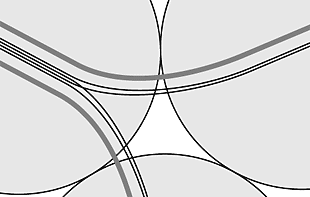 The metro lines would become 4-track where the branches join, so the downtown segments of the metro do not limit capacity. The cars are 25 meters long, with 20 rows of 4 seats each and 4 sets of doors on each side. Comprising 12 cars, such a train would be 300 meters long, roughly the practical limiting length for a metro. The reference design calls for what is effectively 12 two-track metros (one in each of the 2 branches of each of the 6 lobes).
If it is known that this capacity is insufficient, a double-deck metro system could be built. This would provide twice the capacity, albeit at higher cost. In extreme cases, a broader track gauge and wider car could be adopted; while there is no modern precedent, some early railroads used a much wider gauge than is now standard (England’s Great Western was originally built to a gauge of 7' 1/4”). Above some size, however, the reference topology would not be able to handle the demand: one of the alternative designs would then have to be adopted.
|
A single metro track can move more than 50,000 seated passengers per hour. This is derived as follows:
This provides the capacity to move nearly 700,000 passengers from outer districts to the center during the peak hour. This should be sufficient for a city of 2,000,000 people (especially given that some passengers will travel from downtown to the outer districts), but may not be adequate for a larger city based on the reference topology. It is worth noting that underground systems are basically immune from weather-related outages and delays. Trams and buses running on the surface can be put entirely out of action by a heavy snowfall, and autumn leaves on the rails will delay trams when it rains. The metro should be designed from the start as a no-fare system, because this allows several improvements while also reducing costs. Without fare collection, station entrances can be arranged solely with regard to the convenience of the passengers. If a fare must be collected, it is necessary either to install fare-collection equipment at each entrance or to require all passengers to pass through a central fare collection point, which increases the distances that many passengers must walk. Multiple entrances and exits also prevent congestion from developing at the single exit often provided on systems that collect fares. Fare collection is typically centralized on a mezzanine, where ticket vending machines, token sales booths, and an enforcement post are located. With a no-fare system, this mezzanine level can be eliminated, saving passengers a flight of steps to reach the boarding platforms. While the elimination of the mezzanine is in itself a considerable savings, it leads indirectly to even greater savings because the tunnels are at least four meters closer to the surface, reducing construction time and saving money, especially in existing cities. Construction at greater depths may also preclude the practical application of cut-and-fill techniques and force the boring of tunnels, still further increasing costs. Security is better at stations without mezzanines because some areas of the platforms are visible from the street, and most areas would be within earshot of someone on the street above (in the absence of roaring car traffic). |
||||||||||||||||||||||||||||||||||||||||||||||||||||||||||||||||||||||||||||||||||||||||||||||||||||||||||||||
|
According to Ishi Masaaki Shiraishi, this arrangement is already in use at Shinjuku and two other rail stations in Tokyo.
Platform arrangement for the 2-track section of the metro; the arrangement is doubled in the 4-track sections. Passengers can always board the first metro to arrive, and both sets of doors are used. |
A somewhat unusual arrangement of platforms would speed boarding and disembarking and would help to hold station dwell times down to the assumed 12 seconds. A center platform between the tracks is used exclusively by embarking passengers. The other two platforms, located on the outside of the tracks, would be used by disembarking passengers. The downtown sections of the system are four tracks wide, and here boarding platforms are located between the two lines traveling in the same direction, with the disembarking platforms located outside. This arrangement allows people to catch whichever of the two trains may come along first, which can save passengers a couple of minutes. The use of doors on both sides of the train reduces the required number of doors and makes more efficient use of them. After decades of failed attempts, metro trains are now operating safely without drivers, greatly reducing personnel costs. Only a fully grade-separated system can safely operate without drivers because conflicts with other traffic cannot be permitted. Fully-automated systems are also free from strike-related outages. |
||||||||||||||||||||||||||||||||||||||||||||||||||||||||||||||||||||||||||||||||||||||||||||||||||||||||||||||
Tram |
|||||||||||||||||||||||||||||||||||||||||||||||||||||||||||||||||||||||||||||||||||||||||||||||||||||||||||||||
|
Amsterdam’s recent metro line 51 is an odd and unsatisfactory hybrid system called a “fast tram.” The trams are subject to the strict signaling controls typical of a metro, but the tracks run on the surface and have many grade crossings. In the eight years since its opening, 8 people have been struck and killed by the tram, and an average of 17 have been injured each year. Speeds have been reduced but people are still struck while crossing the tracks. This line was built on the surface as an economy measure, but there is now talk of putting it underground or in the air, at vast expense. "Dodenlijn 51 naar Amstelveen moet ondergronds" NRC Handelsblad, 2 September 1998 |
A tram system is also well suited to the requirements of the carfree city, provided that the population is not too large: the capacity of a tram system is about half that of a metro system. The electric tram is about as old as the electric metro train, and like the metro, it is a reliable, mature technology. The important advantages of tram systems are their much lower construction costs and the pleasant view enjoyed by the passengers. It is somewhat slower than a metro because safety and noise considerations limit the speed of surface vehicles to about 50 km/hr. Surface vehicles will occasionally collide with other vehicles and pedestrians, so trams are not as safe as a metro. The danger has been found to be tolerable and can be reduced by separating the two tracks by several meters, so one tram does not conceal the approach of another. Better still would be the division of the central boulevard into two streets, each one-way, separated by a row of buildings. The slower speeds of a tram system are partially offset by reduced waiting time - trams need to run more frequently to provide the required capacity. No two points in the reference design are more than 36.5 minutes apart, assuming that trams run once a minute. The itinerary of the longest trip breaks down as follows: |
||||||||||||||||||||||||||||||||||||||||||||||||||||||||||||||||||||||||||||||||||||||||||||||||||||||||||||||
|
|||||||||||||||||||||||||||||||||||||||||||||||||||||||||||||||||||||||||||||||||||||||||||||||||||||||||||||||
| The San Diego Trolley and the Sacramento systems cost between $9,000,000 and $9,600,000 per mile, according to recent postings on the cons-spst-sprawl-trans list. | The assumed maximum speed of 50 km/hr is well within contemporary limits. Here again, the required acceleration is 0.1875 G. Tram systems can be constructed for as little as $5,500,000/km if built entirely at grade. | ||||||||||||||||||||||||||||||||||||||||||||||||||||||||||||||||||||||||||||||||||||||||||||||||||||||||||||||
| A tram system can move more than 27,000 seated passengers per hour in each direction. This is derived as follows: | |||||||||||||||||||||||||||||||||||||||||||||||||||||||||||||||||||||||||||||||||||||||||||||||||||||||||||||||
| This is based on a car length of 15 m with 12.5 rows of seats and two sets of doors on each side. With 3 cars of 15 m length, a tram would be 45 m long, which is about as long as is desirable for an at-grade system. |
|
||||||||||||||||||||||||||||||||||||||||||||||||||||||||||||||||||||||||||||||||||||||||||||||||||||||||||||||
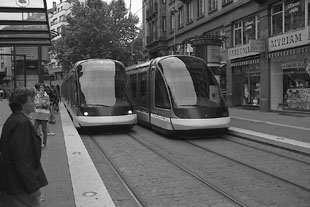 Low-level boarding platforms in Strasbourg. Notice also how easy it would be to step in front of an oncoming tram hidden behind another tram. Separating the two tracks by 2 meters avoids the problem. |
Based on 12 two-track tram lines, the system has enough capacity to move more than 300,000 passengers from outer districts to the center during the peak hour. This should be sufficient for a city of 1,000,000 people. Trams (and all other public transport vehicles) work best when the floor level of the tram at the same height as the boarding platform. This makes it much easier for the infirm to board, and permits wheeled vehicles such as baby strollers and bicycles to be brought rapidly aboard. With low-floor trams, the floors are as little as 36 cm above the ground, permitting the construction of unobtrusive, inexpensive level-loading platforms to ease and speed boarding. Trams normally run without complex signaling systems. The driver sees indications of switch (points) settings but often no other signals besides regular traffic lights. The driver must avoid collisions with all street traffic, including other trams, be they stopped or crossing in front. Metro systems, on the other hand, are built with interlocking signal systems and automatic enforcement of signal restrictions; collisions are in principle impossible and in practice extremely rare. |
||||||||||||||||||||||||||||||||||||||||||||||||||||||||||||||||||||||||||||||||||||||||||||||||||||||||||||||
Buses |
|||||||||||||||||||||||||||||||||||||||||||||||||||||||||||||||||||||||||||||||||||||||||||||||||||||||||||||||
|
See p__ for a discussion |
A sophisticated bus system, such as that in Curitiba, Brazil, could be made to serve the passenger transport needs of a carfree city. A bus system may even be preferable during the construction phase, but, except in small cities, the intrinsic disadvantages of buses outweigh their initial economies. Buses are uncomfortable due to their lurching ride and narrow seats, but on smoothly paved streets they can provide an acceptable level of service. Acceleration is low despite the relatively large engines employed, and the rough, lurching ride really does not allow much higher rates of acceleration in any case. | ||||||||||||||||||||||||||||||||||||||||||||||||||||||||||||||||||||||||||||||||||||||||||||||||||||||||||||||
| There is a great deal of experience with buses, not all of it good. A generation of so-called "Advanced Design Buses" dating to 1977 was heavy, inefficient, unreliable, and expensive. Newer buses are better in most respects, and many of them are partially or even entirely low-floor designs. | |||||||||||||||||||||||||||||||||||||||||||||||||||||||||||||||||||||||||||||||||||||||||||||||||||||||||||||||
|
I lived at the top of a steep hill in San Francisco when a new trolley-bus line replaced diesel buses. The change was wonderful. The diesel buses had crawled up the hill with their engines roaring; the trolley buses climbed the hill quickly and made almost no noise at all. It is not out of the question to install overhead wires only at bus stops, where the bus would quickly recharge a small bank of batteries before moving on to the next stop. |
Most buses are diesel powered and emit unhealthy, stinking exhaust. They are unreasonably noisy. Natural gas has been used experimentally as a replacement for diesel fuel in buses, and while this helps clean up the exhaust, the noise problem remains. However, the use of electric trolley buses provides somewhat better acceleration, greatly reduces noise levels, and completely eliminates local exhaust emissions. The overhead wiring is complex, expensive, and unsightly because electric buses require twin overhead conductors, whereas trams require just a single wire, using the rails to complete the circuit. Both diesel and electric buses can be made to work reasonably well, and their later replacement with a tram or metro system presents no special difficulty. | ||||||||||||||||||||||||||||||||||||||||||||||||||||||||||||||||||||||||||||||||||||||||||||||||||||||||||||||
| We would have to accept that a bus system would provide slower service than either of the rail-based alternatives. The numbers work out as follows: | |||||||||||||||||||||||||||||||||||||||||||||||||||||||||||||||||||||||||||||||||||||||||||||||||||||||||||||||
|
|||||||||||||||||||||||||||||||||||||||||||||||||||||||||||||||||||||||||||||||||||||||||||||||||||||||||||||||
| This yields a capacity of about 150,000 passengers from outer districts to the center during the peak hour, sufficient to support a population of about 500,000. It might be possible to shorten the headway to 10 seconds, doubling the peak capacity, but at this frequency, traffic congestion becomes a serious issue, and the sheer volume of traffic would burden homes and businesses located along the central boulevard. | |||||||||||||||||||||||||||||||||||||||||||||||||||||||||||||||||||||||||||||||||||||||||||||||||||||||||||||||
Personal Rapid Transport |
|||||||||||||||||||||||||||||||||||||||||||||||||||||||||||||||||||||||||||||||||||||||||||||||||||||||||||||||
| Using the optimistic “People Pods” scenario, the maximum riding time between any two stations in the reference design would be less than 6 minutes. Assuming one never had to wait for a vehicle, the maximum transit time between any two doorsteps would be under 16 minutes. If it became possible to increase the number of stations, so that each neighborhood had 6 or 8 stops, even faster times become possible because of the reduced walking distances. This system is still speculative: it is an invention that has yet to be manufactured. http://www.canosoarus.com/05MagLev/Pod01.htm | As noted in "Better Public Transport," PRT is a technology still under development, and costs and capacities do not yet compare favorably with conventional rail systems. This situation may change, and PRT may eventually offer equivalent capacities, affordable costs, private vehicles, and better speeds. PRT systems might then be applied to the reference design for carfree cities, possibly with some modifications. PRT systems do not offer any compelling advantage over conventional urban rail systems, except possibly speed. Some systems in advanced stages of development could in theory offer faster service than a metro because they provide for direct routing - the passenger would make no intermediate stops. These systems, however, have capacity limitations that preclude their use in larger cities. | ||||||||||||||||||||||||||||||||||||||||||||||||||||||||||||||||||||||||||||||||||||||||||||||||||||||||||||||
| PRT is not, in any case, necessary for the construction of carfree cities. Some day, it may offer even better service than a metro or tram, but we need not wait for this development before building carfree cities. | |||||||||||||||||||||||||||||||||||||||||||||||||||||||||||||||||||||||||||||||||||||||||||||||||||||||||||||||
Pros & Cons of Each System |
|||||||||||||||||||||||||||||||||||||||||||||||||||||||||||||||||||||||||||||||||||||||||||||||||||||||||||||||
| The following table summarizes the pros and cons of various transport systems as applied to the reference design. The choice of a different topology or the application of the reference design to a larger population affects the analysis somewhat, but it should remain a useful guide. | |||||||||||||||||||||||||||||||||||||||||||||||||||||||||||||||||||||||||||||||||||||||||||||||||||||||||||||||
|
Both trams and buses are capable of much higher speeds, but I have taken 50 km/hr as the maximum safe speed for surface transit in populated areas. |
|
||||||||||||||||||||||||||||||||||||||||||||||||||||||||||||||||||||||||||||||||||||||||||||||||||||||||||||||
Special Circumstances |
|||||||||||||||||||||||||||||||||||||||||||||||||||||||||||||||||||||||||||||||||||||||||||||||||||||||||||||||
| A number of unusual circumstances must be considered and solutions found for these special needs. | |||||||||||||||||||||||||||||||||||||||||||||||||||||||||||||||||||||||||||||||||||||||||||||||||||||||||||||||
Baggage: You Can Take It with You |
|||||||||||||||||||||||||||||||||||||||||||||||||||||||||||||||||||||||||||||||||||||||||||||||||||||||||||||||
| Passengers often need to carry small-and medium-sized goods with them, and one great advantage of a car is the ease with which this can be done. Provision must be made for people to move objects the size of a suitcase and preferably considerably larger. The simplest solution is the use of small, collapsible hand carts. Such carts, supplemented by a range of larger, heavier carts, would allow people to haul quite large and heavy objects onto the metro trains or trams, but the boarding platforms must be at the same height as vehicle floors for this to work. This is difficult to arrange with buses, even using level loading platforms (such as were installed in Curitiba) because of the wider platform-floor gap required by manually-guided vehicles. | |||||||||||||||||||||||||||||||||||||||||||||||||||||||||||||||||||||||||||||||||||||||||||||||||||||||||||||||
Public Emergencies |
|||||||||||||||||||||||||||||||||||||||||||||||||||||||||||||||||||||||||||||||||||||||||||||||||||||||||||||||
|
The US Interstate system was ostensibly built to permit the evacuation of cities during a nuclear threat, but the capacity of the system was never sufficient to quickly evacuate a large city.
Small electric taxis, such as this one in Zermatt, Switzerland, could be used for personal emergencies. Even these taxis present problems–their speeds are high enough to be a threat, and the drivers are somewhat aggressive. Smaller, speed regulated taxis could alleviate these problems. |
A range of public emergencies must be considered. It is difficult to imagine all the possibilities, but the most pressing and difficult circumstance would be the total evacuation of a city. Most residents of a carfree city would have a bicycle, so most of the population could simply bike into the surrounding countryside; long lines of people desperate to buy gasoline would not arise. It is a simple matter to attach a trailer to a bike, allowing evacuees to carry food, clothing, and a tent. There would be enough capacity in the tram or metro system to move the entire population to the outer edge of the city in about three hours, where some could travel further by car. The central rail station allows evacuation of the infirm.
Personal EmergenciesSome form of alternative transport must be available for the rare occasions when someone is suddenly indisposed. Ordinary ambulances will transport the seriously ill, but others who are suddenly taken sick will need a ride home. Likewise, someone who has just learned of the death of a family member may not want to share his grief with the larger community. On these occasions, people will need a way to get home that does not depend on automobiles. The per-trip cost can be quite high, and radio-dispatched pedicabs or slow battery-powered taxis could meet this need. |
||||||||||||||||||||||||||||||||||||||||||||||||||||||||||||||||||||||||||||||||||||||||||||||||||||||||||||||
Segregated First-Class Space |
|||||||||||||||||||||||||||||||||||||||||||||||||||||||||||||||||||||||||||||||||||||||||||||||||||||||||||||||
| Some cultures provide high-status transport for the richest members of society, who may demand privacy and unusually posh accommodation. In Venice, luxury transport is provided by water taxis. Elsewhere it is usually provided by chauffeur-driven limousines. Paris, however, offers first-class metro cars, and similar luxury can be offered wherever demand is sufficient to pay the full costs. On a fare-free system, the easiest method of fare collection is probably to offer monthly first-class passes. Fare enforcement can be provided by a conductor riding in the first class car. | |||||||||||||||||||||||||||||||||||||||||||||||||||||||||||||||||||||||||||||||||||||||||||||||||||||||||||||||
Cavalcades |
|||||||||||||||||||||||||||||||||||||||||||||||||||||||||||||||||||||||||||||||||||||||||||||||||||||||||||||||
| Formal occasions may require the use of a cavalcade, the usual limousine motorcade being replaced by horse-drawn carriages. This expensive arrangement is rarely needed. | |||||||||||||||||||||||||||||||||||||||||||||||||||||||||||||||||||||||||||||||||||||||||||||||||||||||||||||||
Intercity Transport |
|||||||||||||||||||||||||||||||||||||||||||||||||||||||||||||||||||||||||||||||||||||||||||||||||||||||||||||||
| The question of transport from a carfree city to outlying areas and other cities must be considered. All of the usual transport modes are supported by the reference design. | |||||||||||||||||||||||||||||||||||||||||||||||||||||||||||||||||||||||||||||||||||||||||||||||||||||||||||||||
Suburban Commuters |
|||||||||||||||||||||||||||||||||||||||||||||||||||||||||||||||||||||||||||||||||||||||||||||||||||||||||||||||
| Some employees will doubtless live outside the carfree city and commute to jobs in the city. The carfree arrangement will actually ease the commutes even of those who elect to drive to the city, because they will no longer have to slog through heavy inner-city traffic: the last leg of their commute will occur on a fast, efficient public transport system. Even for those who drive, total commute time should decline, and a variety of other transport modes will offer service into the city. Any of the modes described below can be used to transport commuters into the city and to provide intercity service to city residents and visitors from afar. | |||||||||||||||||||||||||||||||||||||||||||||||||||||||||||||||||||||||||||||||||||||||||||||||||||||||||||||||
Intercity Trains |
|||||||||||||||||||||||||||||||||||||||||||||||||||||||||||||||||||||||||||||||||||||||||||||||||||||||||||||||
|
TGV is an acronym derived from the French "Trein à Grande Vitesse," literally, “high-speed train.” |
I believe that the intrinsic advantages of rail systems will lead in the coming decades to a renaissance in intercity rail travel. Intercity trains have long been important in Europe and Japan, and even in the USA they once provided most intercity transport. In many parts of the world, intercity rail traffic has continued to grow, although often at a slower pace than road and air traffic. Concerns about pollution and energy consumption have focused increased attention on rail travel, and high-speed rail systems have successfully lured passengers away from other modes. The Paris-Lyon market, for instance, once largely in the hands of the airlines, was substantially captured by the TGV line, which offers equal or better end-to-end travel times. It seems clear that a carfree city should be planned to take as much advantage of intercity rail service as possible, so the rail infrastructure should be designed to accommodate a high traffic volume. | ||||||||||||||||||||||||||||||||||||||||||||||||||||||||||||||||||||||||||||||||||||||||||||||||||||||||||||||
| The logical location for the intercity rail station is underground in the very heart of the city. In this location, it can be directly served by two of the three metro/tram lines, and no part of the city is more than about 20 minutes away. Tunnels leading to an underground station minimize the land consumed by intercity transport and greatly reduce the noise burden. Once the tracks are a kilometer away from inhabited areas, they can be brought to the surface. A six-track railroad broadening to a 12-track station should be able to accommodate as much traffic as is likely to arise. | |||||||||||||||||||||||||||||||||||||||||||||||||||||||||||||||||||||||||||||||||||||||||||||||||||||||||||||||
Buses |
|||||||||||||||||||||||||||||||||||||||||||||||||||||||||||||||||||||||||||||||||||||||||||||||||||||||||||||||
| Bus terminals would be built in some of the utility areas, close to the transport stops for easy accessibility. The utility areas are directly connected to the external highway network, permitting rapid access to superhighways without the usual need to slog through city traffic. Buses would be used mainly to provide service between the carfree city and nearby towns. | |||||||||||||||||||||||||||||||||||||||||||||||||||||||||||||||||||||||||||||||||||||||||||||||||||||||||||||||
Airport |
|||||||||||||||||||||||||||||||||||||||||||||||||||||||||||||||||||||||||||||||||||||||||||||||||||||||||||||||
| A carfree city of 1,000,000 would be large enough to support its own airport. Transport to the airport should be provided by a rail link from downtown. It goes without saying that the airport should be located far out of town to minimize the noise burden on the city. | |||||||||||||||||||||||||||||||||||||||||||||||||||||||||||||||||||||||||||||||||||||||||||||||||||||||||||||||
Hotel Shuttles |
|||||||||||||||||||||||||||||||||||||||||||||||||||||||||||||||||||||||||||||||||||||||||||||||||||||||||||||||
| In most cities, shuttle buses provide service between the airport and major hotels. This has the advantage that passengers and their baggage travel together and that direct service can be offered. Some hotels in the carfree city could be located in the immediate vicinity of the train station, and porters from these hotels could meet arriving passengers on the station platform. Other hotel guests would transfer to the passenger transport system to reach their hotels. It should not be difficult to arrange for through checking of baggage directly the hotel. Bags would be delivered by train from the airport to a baggage depot at the train station, from which it would be dispatched using the freight system in the same way as other packages. | |||||||||||||||||||||||||||||||||||||||||||||||||||||||||||||||||||||||||||||||||||||||||||||||||||||||||||||||
| Hotels catering to charter buses could be located on the edges of the outermost districts, where it would be possible to provide a road connection via the utility areas to the highway system. This small compromise with the carfree design provides guests with much better service. | |||||||||||||||||||||||||||||||||||||||||||||||||||||||||||||||||||||||||||||||||||||||||||||||||||||||||||||||
Cars |
|||||||||||||||||||||||||||||||||||||||||||||||||||||||||||||||||||||||||||||||||||||||||||||||||||||||||||||||
| Residents who make many trips outside the city may prefer to own a car, which would be parked in one of the parking garages located in the utility areas. All locations within the garage would be within a 5-minute walk of the transport stop in the utility area. Those who drive infrequently can save a great deal of money by joining a car-sharing organization or by renting a car when necessary. Parking fees at these garages would be set at a level high enough to cover the full costs of building and operating the garages. The capacity of the garages must be sufficient to accommodate the cars of both residents and those visiting the city by car. In the case of a special event that draws an unusually large public, open grass fields surrounding the utility area could be used provide overflow parking. This would entail relatively long walks to the transport stops on these special occasions. | |||||||||||||||||||||||||||||||||||||||||||||||||||||||||||||||||||||||||||||||||||||||||||||||||||||||||||||||
|
See page __ for a drawing of the utility area and parking garages. See page __ for an illustration of the road connections between the garages and the highway network. |
The garages in the utility areas would be connected directly to the highway system, which should be kept at least 5 kilometers away from the city unless there is an intervening range of hills to serve as a noise barrier. The connections between the garages and the highway system should be arranged to keep traffic as far away from inhabited areas of the city as possible. Moderate speed limits would help ensure that noise from cars on the access roads does not become a burden for residents of neighborhoods near the utility areas. | ||||||||||||||||||||||||||||||||||||||||||||||||||||||||||||||||||||||||||||||||||||||||||||||||||||||||||||||
| This concludes the discussion of passenger transport. We turn next to a more difficult problem: moving freight in a car- and truck-free city. |
![]()
Back to Book Home
Go to Carfree.com
E-mail
carfree.com
Copyright ©1999-2002 J. Crawford
